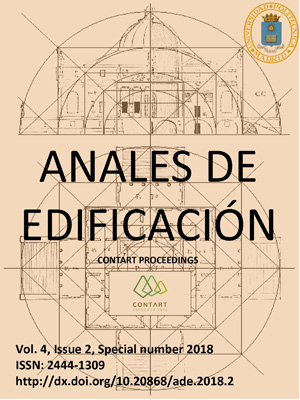Sistema inteligente, sostenible e integrado de gestión de estructuras = Intelligent, sustainable and integrated structure management system
DOI:
https://doi.org/10.20868/ade.2018.3778Palabras clave:
Monitorización estructural, sistemas inalámbricos distribuidos, energy harvesting, LORA, sistemas mínimos Linux, Concrete pavements, recycled concrete, deformation moduleResumen
Resumen
El sistema de monitorización remota Infrasmart diseñado por Tecnalia es usado como base para el desarrollo de supervisión de infraestructuras civiles tanto existentes como de nueva construcción en donde el despliegue de la instalación debe de ser lo menos intrusiva posible. Para conseguir su objetivo el sistema se basa en módulos de adquisición distribuidos con capacidad de comunicación inalámbrica de larga distancia y auto-alimentación orientada a la eliminación del cableado propio de este tipo de instalaciones. A su vez el concentrador de datos gestiona la recepción de la información de dichos módulos y la evacuación de los mismos a un servidor de datos seguro orientado a la supervisión remota de la infraestructura. Actualmente la capacidad de medida de los nodos de adquisición abarca tanto medidas cuasi-estáticas, (sensores de temperatura e hilo vibrante), como medidas dinámicas accionadas por evento, (acelerómetros). En adición existe la capacidad de integrar nuevos sensores conforme a nuevas especificaciones dando como resultado un sistema abierto y escalable en función de los parámetros de interés de la infraestructura a monitorizar.
Abstract
The Infrasmart remote monitoring system designed by Tecnalia is used as a basis for the development of supervision of both existing and new construction civil infrastructures where the deployment of the installation should be as unobtrusive as possible. To achieve its objective, the system is based on distributed acquisition modules with long-distance wireless communication capability and self-feeding aimed at eliminating the wiring of these types of installations. At the same time, the data concentrator manages the reception of the information of said modules and the evacuation thereof to a secure data server oriented to the remote supervision of the infrastructure. Currently, the measurement capacity of the acquisition nodes includes both quasi-static measures (temperature sensors and vibrating wire), and dynamic measurements driven by events (accelerometers). In addition, there is the ability to integrate new sensors according to new specifications resulting in an open and scalable system depending on the parameters of interest of the infrastructure to be monitored.
Descargas
Referencias
Celebi, M., 2002, “Seismic instrumentation of buildings (with emphasis on federal buildings)”. Special GSA/USGS Project, an administrative report.
Farrar, C.R., 2011, “Historical Overview of Structural Health Monitoring. Lecture Notes on Structural Health Monitoring Using Statistical Pattern Recognition”, Los Alamos Dynamics: Los Alamos.
Rosing, Tajana; Todd, Michael; Farrar, Charles; Hodgkiss, William. (2008). “Energy Harvesting for Structural Health Monitoring Sensor Networks”. Journal of Infrastructure Systems - J INFRASTRUCT SYST. 14. 10.1061/(ASCE)1076-0342(2008)14:1(64).
Shinae Jang;, Hongki Jo; Soojin Cho; Kirill Mechitov; Jennifer A.Rice; Sung-Han Sim; Hyung-Jo Jung; Chung-BangYun; Billie F. Spencer, Jr; Gul Agha. “Structural healthmonitoring of a cable-stayed bridge using wireless smartsensor technology: Deployment and evaluation”. SmartStructures and Systems, Vol. 6, No. 5-6 (2010).
Soojin Cho; Hongki Jo, Shinae Jang; Jongwoong Park; Hyung-Jo Jung; Chung-Bang Yun; Billie Spencer; Ju-Won Seo. (2010). “Structural Health Monitoring of a Cable-Stayed Bridge Using Wireless Smart Sensor Technology: Data Analyses”. Smart Structures and Systems. 6. 10.12989/sss.2010.6.5_6.461.
Descargas
Publicado
Número
Sección
Licencia
1. Los autores conservan los derechos de autor y garantizan a la revista el derecho de una Licencia Creative Commons Atribución - Nocomercial 4.0 Internacional que permite a otros compartir el trabajo con un reconocimiento de la autoría y uso no comercial.
2. Los autores pueden establecer por separado acuerdos adicionales para la distribución no exclusiva de la versión de la obra publicada en la revista (por ejemplo, situarlo en un repositorio institucional o publicarlo en un libro).
Salvo indicación contraria, todos los contenidos de la edición electrónica se distribuyen bajo una licencia de uso y distribución “Creative Commons"












